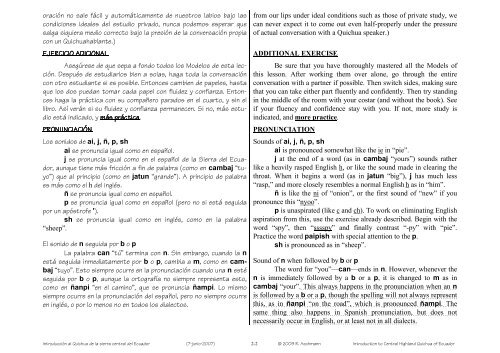Introduction to Central Highland Quichua of Ecuador - Quichua.net
Introduction to Central Highland Quichua of Ecuador - Quichua.net
Introduction to Central Highland Quichua of Ecuador - Quichua.net
You also want an ePaper? Increase the reach of your titles
YUMPU automatically turns print PDFs into web optimized ePapers that Google loves.
oración no sale fácil y au<strong>to</strong>máticamente de nuestros labios bajo las<br />
condiciones ideales del estudio privado, nunca podemos esperar que<br />
salga siquiera medio correc<strong>to</strong> bajo la presión de la conversación propia<br />
con un <strong>Quichua</strong>hablante.)<br />
EJERCICIO EJERCICIO ADICIONAL ADICIONAL<br />
ADDITIONAL EXERCISE<br />
Asegúrese de que sepa a fondo <strong>to</strong>dos los Modelos de esta lección.<br />
Después de estudiarlos bien a solas, haga <strong>to</strong>da la conversación<br />
con otro estudiante si es posible. En<strong>to</strong>nces cambien de papeles, hasta<br />
que los dos puedan <strong>to</strong>mar cada papel con fluidez y confianza. En<strong>to</strong>nces<br />
haga la práctica con su compañero parados en el cuar<strong>to</strong>, y sin el<br />
libro. Así verán si su fluidez y confianza permanecen. Si no, más estudio<br />
está indicado, y más prác prácti prác<br />
ti tica<br />
ca. ca<br />
PRONUNCIACIÓN PRONUNCIACIÓN<br />
PRONUNCIATION<br />
Los sonidos de ai, j, ñ, p, sh<br />
ai se pronuncia igual como en español.<br />
j se pronuncia igual como en el español de la Sierra del <strong>Ecuador</strong>,<br />
aunque tiene más fricción a fin de palabra (como en cambaj “tuyo”)<br />
que al principio (como en jatun “grande”). A principio de palabra<br />
es más como el h del inglés.<br />
ñ se pronuncia igual como en español.<br />
p se pronuncia igual como en español (pero no si está seguida<br />
por un apóstr<strong>of</strong>e ').<br />
sh se pronuncia igual como en inglés, como en la palabra<br />
“sheep”.<br />
El sonido de n seguida por b o p<br />
La palabra can “tú” termina con n. Sin embargo, cuando la n<br />
está seguida inmediatamente por b o p, cambia a m, como en cambaj<br />
“tuyo”. Es<strong>to</strong> siempre ocurre en la pronunciación cuando una n esté<br />
seguida por b o p, aunque la or<strong>to</strong>grafía no siempre representa es<strong>to</strong>,<br />
como en ñanpi “en el camino”, que se pronuncia ñampi. Lo mismo<br />
siempre ocurre en la pronunciación del español, pero no siempre ocurre<br />
en inglés, o por lo menos no en <strong>to</strong>dos los dialec<strong>to</strong>s.<br />
from our lips under ideal conditions such as those <strong>of</strong> private study, we<br />
can never expect it <strong>to</strong> come out even half-properly under the pressure<br />
<strong>of</strong> actual conversation with a <strong>Quichua</strong> speaker.)<br />
Be sure that you have thoroughly mastered all the Models <strong>of</strong><br />
this lesson. After working them over alone, go through the entire<br />
conversation with a partner if possible. Then switch sides, making sure<br />
that you can take either part fluently and confidently. Then try standing<br />
in the middle <strong>of</strong> the room with your costar (and without the book). See<br />
if your fluency and confidence stay with you. If not, more study is<br />
indicated, and more practice.<br />
Sounds <strong>of</strong> ai, j, ñ, p, sh<br />
ai is pronounced somewhat like the ie in “pie”.<br />
j at the end <strong>of</strong> a word (as in cambaj “yours”) sounds rather<br />
like a heavily rasped English h, or like the sound made in clearing the<br />
throat. When it begins a word (as in jatun “big”), j has much less<br />
“rasp,” and more closely resembles a normal English h as in “him”.<br />
ñ is like the ni <strong>of</strong> “onion”, or the first sound <strong>of</strong> “new” if you<br />
pronounce this “nyoo”.<br />
p is unaspirated (like c and ch). To work on eliminating English<br />
aspiration from this, use the exercise already described. Begin with the<br />
word “spy”, then “sssspy” and finally contrast “-py” with “pie”.<br />
Practice the word paipish with special attention <strong>to</strong> the p.<br />
sh is pronounced as in “sheep”.<br />
Sound <strong>of</strong> n when followed by b or p<br />
The word for “you”—can—ends in n. However, whenever the<br />
n is immediately followed by a b or a p, it is changed <strong>to</strong> m as in<br />
cambaj “your”. This always happens in the pronunciation when an n<br />
is followed by a b or a p, though the spelling will not always represent<br />
this, as in ñanpi “on the road”, which is pronounced ñampi. The<br />
same thing also happens in Spanish pronunciation, but does not<br />
necessarily occur in English, or at least not in all dialects.<br />
Introducción al <strong>Quichua</strong> de la sierra central del <strong>Ecuador</strong> (7-junio-2007) 2-2 © 2009 R. Aschmann <strong>Introduction</strong> <strong>to</strong> <strong>Central</strong> <strong>Highland</strong> <strong>Quichua</strong> <strong>of</strong> <strong>Ecuador</strong>


